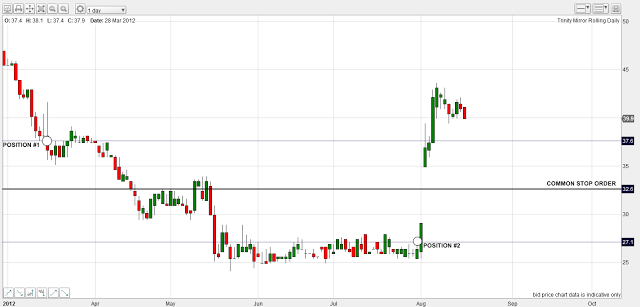One of the golden rules of trading and investment is to never average down, despite the fact that logically this should lower your average purchase price thereby enabling you to break-even much sooner. As I see it, the problems with “averaging down” are twofold:
1) If you’re not careful, averaging down on your falling stock positions can attract all of the cash away from your profitable positions; and when those averaged-down stocks go bust, you’ve lost it all!
2) The very notion that with a lower cost base you can “break even much sooner” means that you will probably do just that — i.e. exit at break even — as soon as you can. So you risked all of your money for the reward of zero profit.
Actually, I don’t think that averaging down is so bad as long as you avoid those two traps by:
1) Averaging down cautiously, and never at the expense of diversification.
2) Letting your combined position run on as a position trade well past the break-even point.
In particular, my own view on “averaging down” is to do so with less risk each time. So, for example:
- On 15 March 2012 I took a £1-per-point long position in Trinity Mirror at about 37p-per-share, with a stop order at 17p-per-share giving a risk of £20.
- On 30 July 2012 I took a second £1-per-point long position in Trinity Mirror at about 27p-per-share, with a stop order at 17p-per-share (again) giving an additional risk of £10.
Although the cumulative risk on this “averaging down” had increased, the additional risk (to the common stop order) of £10 was only half the original risk of £20.
Some weeks later, the price of Trinity Mirror shares has recovered such that both positions are in profit and the common stop order has been trailed such that the residual risk on the first position is more-or-less equal to the locked-in profit on the second position. See here in the chart courtesy of Capital Spreads (annotated):
The bottom line is that if my common stop order (it’s actually two stop orders, of course) gets triggered, I will break even overall. And that’s the worst-case scenario. In the best case scenarios I could either close both positions right now for a combined profit, or let them run as a kind of pyramided position trade until… who knows when?
Actually, I do know when. Since my maximum risk was £20 + £10 = £30, I should wait at least until the combined profit is £60 before I think about closing the trade(s).
Disclaimer: this posting is for general education only; it is not trading advice.

